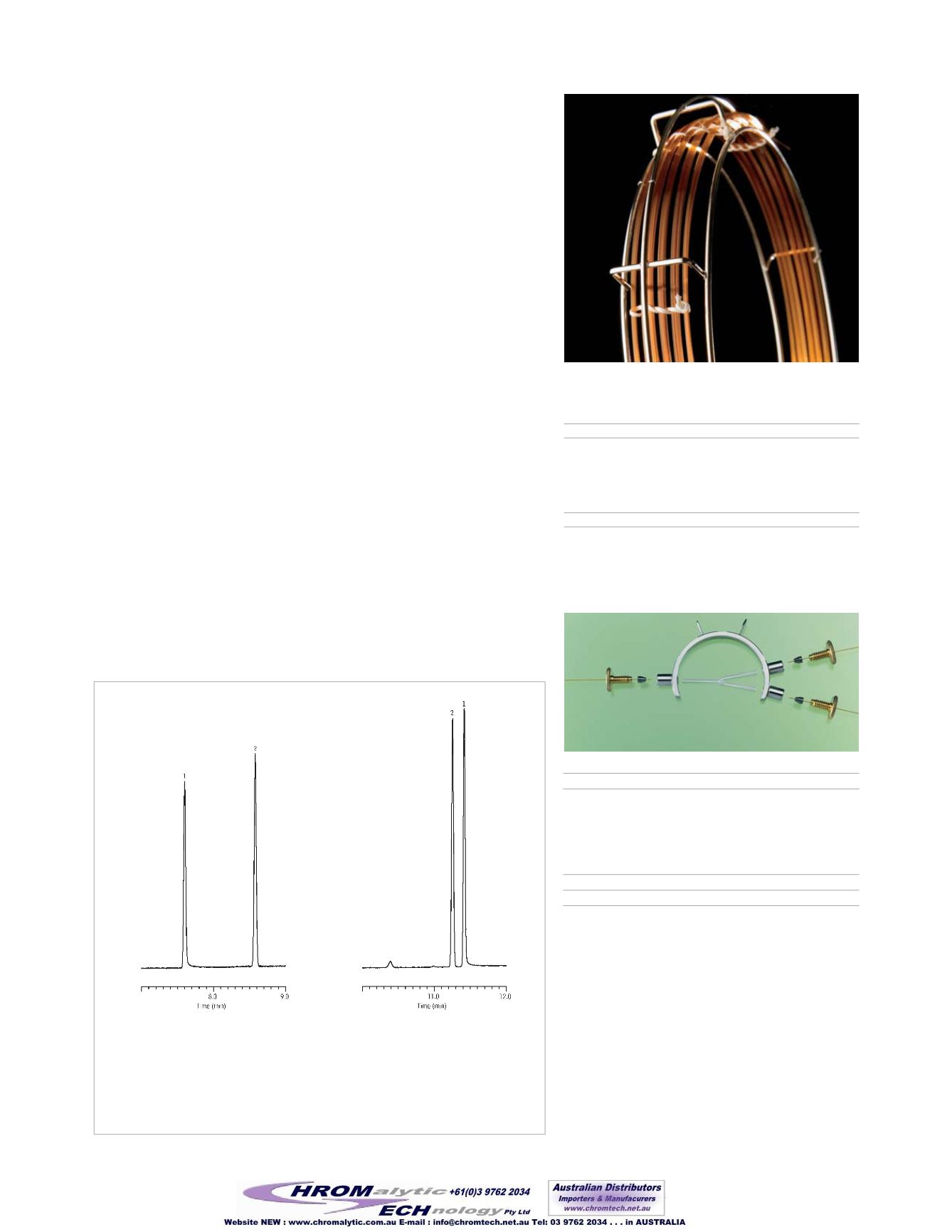

•
4
•
800-356-1688 •
www.restek.com2005 vol. 3
1. 1, 4-butanediol
2.
γ
-butyrolactone
GC_PH00783
GC_PH00784
Column:
Rtx
®
-BAC1 30m, 0.32 mm ID, 1.8µm (cat.# 18003) and Rtx
®
-BAC2 30m, 0.32 mmID,
1.2µm (cat.# 18002)
Sample:
100µg/mL each
γ
-butyrolactone (GBL) and 1, 4-butanediol in methanol
Inj.:
1.0µL split (split ratio 1:10), 4mm single gooseneck inlet liner with wool (cat. # 22405)
Inj. Temp.:
240°C
Carrier Gas:
helium, constant flow
Flow Rate:
3.0mL/min.
Oven Temp.:
50°C to 240°C @ 10°C/min. (hold 2 min.)
Det.:
FID @ 240°C
Rtx®-BAC1
Rtx®-BAC2
Figure 6
γ
-butyrolactone & 1,4-butanediol on
Rtx®-BAC1 & Rtx®-BAC2 Columns.
SeCure™“Y”Connector Kit
SeCure™ “Y” connector body, 3 knurled nuts, “Y”
Universal Press-Tight
®
union, 3 ferrules.
Intermediate-Polarity Deactivated Guard
Columns/Transfer Lines
Rtx®-BAC1 Columns (fused silica)
ID df (µm)
temp. limits
length cat. #
0.32mm 1.80 -20 to 240/260°C 30-Meter 18003
0.53mm 3.00 -20 to 240/260°C 30-Meter 18001
Rtx®-BAC2 Columns (fused silica)
ID df (µm)
temp. limits
length cat. #
0.32mm 1.20 -20 to 240/260°C 30-Meter 18002
0.53mm 2.00 -20 to 240/260°C 30-Meter 18000
Description
Ferrules Fit Column ID qty. cat.#
Connector Kit
0.28/0.32mm kit 20277
Nominal ID
Nominal OD
5-Meter
0.32mm
0.45 ± 0.04mm 10044
0.53mm
0.69 ± 0.05mm 10045
The SeCure
™
“Y” connector’s open design allows visu-
al confirmation of the seal; secondary seals ensure a
leak-tight connection.
We designed Rtx®-BAC1 and Rtx®-BAC2 columns for blood alcohol analysis
by headspace GC/FID (Figure 1), but many other materials of forensic interest
also can be analyzed and confirmed using this column pair in a headspace
GC/FID system, including inhalant anesthetics, alkyl nitrites, glycols, industri-
al solvents, and petroleum hydrocarbons. The substances in these target groups
are resolved to baseline on one column or the other. Inhalants (Figure 2) or
alkyl nitrites and their alcohol metabolites (Figure 3), for example, show excel-
lent resolution and responses, and symmetrical peak shapes, in short analysis
times. Similarly, performance is excellent for common industrial solvents
(Figure 4). Retention times for many compounds of interest are presented in
Table 1.1
For the analysis and confirmation of blood alcohols or other materials on
Rtx®-BAC1 and Rtx®-BAC2 columns, we use a GC/FID equipped with a head-
space autosampler that simultaneously introduces sample onto the two analyt-
ical columns. This dual column technique increases throughput by providing
screening and confirmation data from a single injection. By using 0.32mm ID
columns and a high carrier gas flow rate, we achieve baseline resolution of
blood alcohol compounds in less than 3 minutes (Figure 1).
Other abused substances of interest, such as gamma-hydroxybutyrate (GHB,
the “date rape drug”), and poisons, such as ethylene glycol, typically are ana-
lyzed from liquid injections. The Rtx®-BAC1 / Rtx®-BAC2 dual column system
coupled with FID assures excellent responses and peak shapes for ethylene gly-
col and propylene glycol (Figure 5) or for GHB (Figure 6), which usually is con-
verted to gamma-butyrolactone (GBL) for the analysis.
By analyzing these abused substances and poisons simultaneously on Rtx®-
BAC1 and Rtx®-BAC2 columns, compounds coeluting on one stationary phase
are resolved on the complementary stationary phase, and analytical and con-
firmation data are obtained in half the time required with sequential injections.
Analytes characteristically are eluted with excellent responses and peak shapes.
These example applications establish dual column analysis and confirmation
on Rtx®-BAC1 and Rtx®-BAC2 columns as a very useful and highly adaptable
forensics technique.
additional
reading
Clarke’s Analysis of Drugs and Poisons
, Third Edition, A.C. Moffat, M.D.
Osselton and B. Widdop (editors), Pharmaceutical Press, 2004.
Drug-Facilitated Sexual Assault: A Forensic Handbook
, Marc A. LeBeau
and Ashraf Mozayani, Academic Press, 2001
Handbook of Forensic Drug Analysis
, Frederick P. Smith and Jay A. Siegel
(editors), Academic Press, 2004
¹For more information about analyses of anesthetics, or for analyses of
petroleum hydrocarbons, please request Application Note 59548 or
59574, respectively.


















